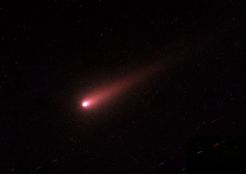Nov 11 2013
ISON is approaching the Sun. An international observation campaign which involves ground-based telescopes, space probes and space telescopes has been running for some time and is already providing initial findings. The comet is now in the sights of the STEREO twin probes which monitor our Sun and how it affects the space weather from their orbits. The Max Planck Institute for Solar System Research in Katlenburg-Lindau is also integrated into the scientific activities.
 ISON is approaching: This photo was taken on 16 October with a telescope at the Turkish National Observatory near Antalya. © TUG / MPS
ISON is approaching: This photo was taken on 16 October with a telescope at the Turkish National Observatory near Antalya. © TUG / MPS
Having passed Mars by a few weeks ago, comet ISON is now entering the last stage of its journey to the Sun: on 28 November the comet will hurtle past the Sun at a distance of just over one million kilometres. In the days after it has passed by the Sun, ISON could develop into a spectacular phenomenon in the night sky which can easily be seen with the naked eye.
“ISON combines two properties which make it a real stroke of luck for research,” says comet researcher Hermann Böhnhardt, who heads the ISON activities at the Max Planck Institute for Solar System Research. ISON will come very close to the Sun, for one. At surface temperatures of up to 2000 degrees Kelvin, metals and other substances could vaporize instead of remaining bound up in the comet material, as is usually the case. Here, they are inaccessible to investigations undertaken with telescopes - and are thus largely unknown as yet.
On the other hand, ISON was already surprisingly bright when it was discovered a year ago. The observations of recent months have put a damper on the expectations a little, however: the brightness of the comet has not increased as strongly as was initially thought. Nevertheless, even the most recent predictions expect the comet will probably remain an object that is unusually easy to see and worthwhile observing.
Moreover, there are many indications that the comet, which can already be clearly seen on the images of ground-based and space-based telescopes, is possibly now advancing into the inner solar system for the first time. Its trajectory is so elongated that it has apparently remained hidden in the depths and cold of space for most of his life since it was born billions of years ago. This is also fortunate. “These so-called non-periodic comets contain uncontaminated information from the birth of our solar system,” says Böhnhardt.
ISON is a fossil from the time our planetary system was born, more so than bodies such as Halley’s Comet, whose significantly smaller elliptic trajectories regularly lead them up close to the Sun. While the inner planets changed gradually, partly due to the influence of the Sun, and developed into solid bodies with a dearth of gas and water, the original conditions remained conserved in the cometary ice at the edge of the solar system.
The latest observations indicate that the debutant possesses a further special feature: its axis of rotation seems to be pointing towards the Sun. In this constellation, one side of the comet is permanently turned away from the hot, seething destination on its approach to the Sun. Only when ISON’s trajectory begins to curve more pronouncedly at the end of November will this material be heated up as well.